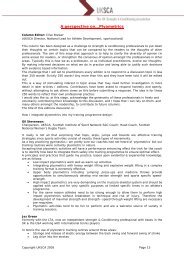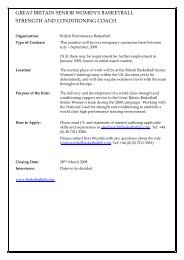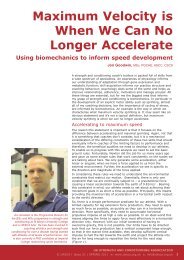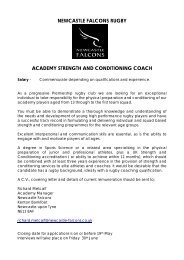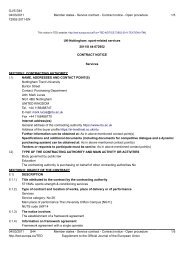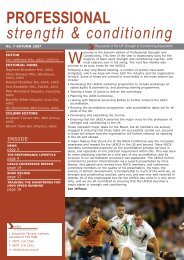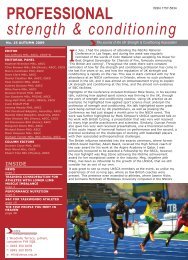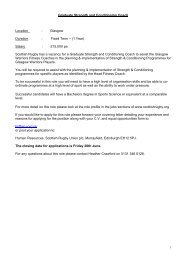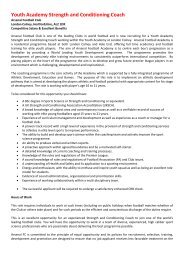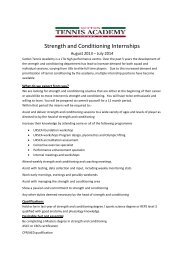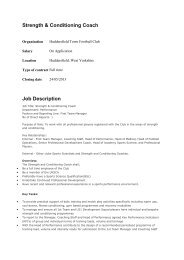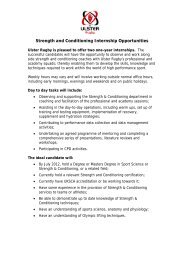uksca news june 2010.qxp
uksca news june 2010.qxp
uksca news june 2010.qxp
Create successful ePaper yourself
Turn your PDF publications into a flip-book with our unique Google optimized e-Paper software.
EXERCISE OF THE MONTH<br />
The Jump Squat<br />
Tim Silvester, BSc (Hons), ASCC<br />
Tim Silvester is a full-time S&C Coach (UKSCA<br />
Accredited) with the Sportscotland Institute of Sport<br />
(West), and is responsible for the design and<br />
delivery of S&C support for netball and wrestling.<br />
He also works with cycling, golf, rowing and<br />
trampoline.<br />
Tim is a graduate of Strathclyde University with a<br />
BSc (Hons) in Sport and Exercise Science, and has<br />
a background in sprinting and rugby, with over 30<br />
year’s of competitive playing experience at club<br />
level.<br />
Stuart is currently the Head Strength and<br />
Conditioning Coach for Glasgow Warriors. Stuart<br />
has previously worked as a Lead S&C coach for<br />
both the Scottish and English Institutes of Sport.<br />
Before working in rugby, Stuart was the Lead S&C<br />
coach for British Judo and England and GB<br />
Women’s Hockey. Stuart has a unique combination<br />
of skills, as he graduated and worked as a<br />
physiotherapist prior to working full-time as a<br />
strength and conditioning coach. Stuart’s sporting<br />
achievements lie in the sport of Olympic<br />
Weightlifting, where he represented Scotland at two<br />
Commonwealth Games.<br />
Stuart Yule is the column editor for the<br />
‘Exercise of the Month’ section.<br />
Introduction<br />
The jump squat, or squat jump as it may also be referred to,<br />
is used within strength and conditioning programmes to<br />
develop lower limb power and increase movement velocities. It<br />
achieves this via an increased rate of force development<br />
(RFD), but with no significant, reduction in peak force in<br />
comparison with a standard back squat.<br />
Typical contraction times to maximum force for large human<br />
limb muscles are > 300ms. However, fast limb movements in<br />
sprinting and boxing involve contraction times of 50–250ms.<br />
Therefore, an increase in contractile RFD would significantly<br />
affect the force and velocity achieved during fast limb<br />
movements. 1<br />
The jump squat can be used in conjunction with, or as an<br />
alternative to, the various weightlifting movements. However,<br />
some may argue that weightlifting movements typically<br />
produce higher power outputs and a greater rate of force<br />
production when performed correctly.<br />
It is beyond the scope of this article to discuss this further, or<br />
to debate the use of one exercise above another. Suffice to<br />
say, the jump squat is another option to add to the S&C<br />
coach’s tool box of exercises.<br />
Rationale<br />
The jump squat is a power exercise that engages the major<br />
extensors of the lower limbs (Fig 1) in a high velocity<br />
movement. When repeated without pause, this becomes a<br />
ballistic exercise that may be used as part of a plyometrics<br />
programme.<br />
Not all athletes have the coordination, technical or physical<br />
ability to gain maximum benefit from weightlifting movements,<br />
and therefore the jump squat can offer an alternative method<br />
of developing explosive power.<br />
Overview<br />
The jump squat has been described in several variations. It<br />
can:<br />
• utilise either a self selected or predetermined squat depth<br />
• be initiated with either a countermovement or from a static<br />
start in the squat position<br />
• be carried out with either a pause between repetitions or<br />
with continuous repeated efforts<br />
For the purpose of this article, two variations will be discussed.<br />
Gluteus Maximus<br />
Hip extension<br />
Gluteus Medius Hip extension and lateral hip rotation<br />
Quadriceps<br />
Knee extension<br />
Hamstrings<br />
Hip extension<br />
Erector spinae<br />
Spinal and pelvic stabilisation<br />
Latissimus dorsi<br />
Spinal and pelvic stabilisation<br />
Adductors<br />
Hip extension and stabilisation<br />
Abdominals<br />
Spinal and pelvic stabilisation<br />
Fig 1. Major muscle groups involved in the jump squat.<br />
22<br />
UK STRENGTH AND CONDITIONING ASSOCIATION<br />
© UKSCA | Issue 18 | Summer 2010 w: www.<strong>uksca</strong>.org.uk e: info@<strong>uksca</strong>.org.uk



